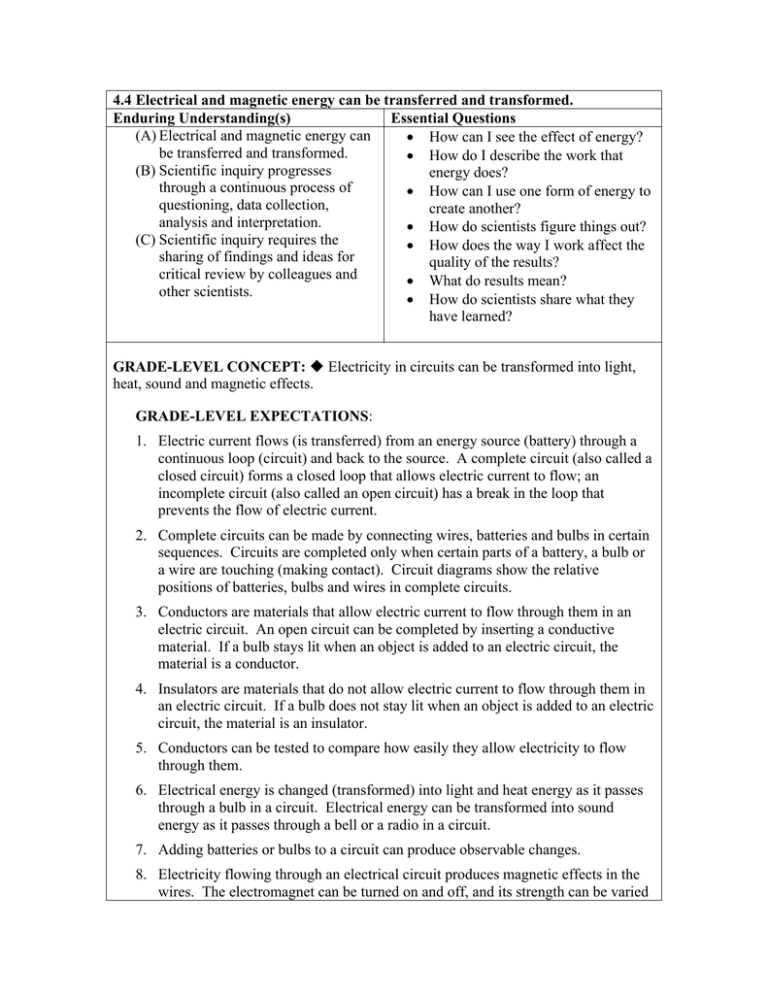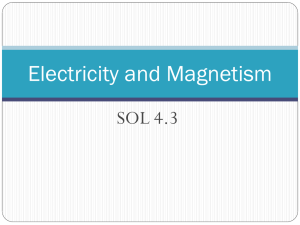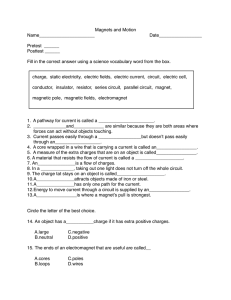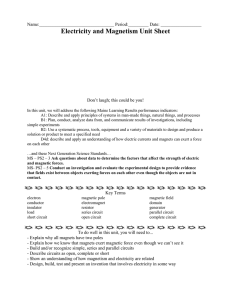4.4 Electrical and magnetic energy can be transferred and
advertisement

4.4 Electrical and magnetic energy can be transferred and transformed. Enduring Understanding(s) Essential Questions (A) Electrical and magnetic energy can • How can I see the effect of energy? be transferred and transformed. • How do I describe the work that (B) Scientific inquiry progresses energy does? through a continuous process of • How can I use one form of energy to questioning, data collection, create another? analysis and interpretation. • How do scientists figure things out? (C) Scientific inquiry requires the • How does the way I work affect the sharing of findings and ideas for quality of the results? critical review by colleagues and • What do results mean? other scientists. • How do scientists share what they have learned? GRADE-LEVEL CONCEPT: Electricity in circuits can be transformed into light, heat, sound and magnetic effects. GRADE-LEVEL EXPECTATIONS: 1. Electric current flows (is transferred) from an energy source (battery) through a continuous loop (circuit) and back to the source. A complete circuit (also called a closed circuit) forms a closed loop that allows electric current to flow; an incomplete circuit (also called an open circuit) has a break in the loop that prevents the flow of electric current. 2. Complete circuits can be made by connecting wires, batteries and bulbs in certain sequences. Circuits are completed only when certain parts of a battery, a bulb or a wire are touching (making contact). Circuit diagrams show the relative positions of batteries, bulbs and wires in complete circuits. 3. Conductors are materials that allow electric current to flow through them in an electric circuit. An open circuit can be completed by inserting a conductive material. If a bulb stays lit when an object is added to an electric circuit, the material is a conductor. 4. Insulators are materials that do not allow electric current to flow through them in an electric circuit. If a bulb does not stay lit when an object is added to an electric circuit, the material is an insulator. 5. Conductors can be tested to compare how easily they allow electricity to flow through them. 6. Electrical energy is changed (transformed) into light and heat energy as it passes through a bulb in a circuit. Electrical energy can be transformed into sound energy as it passes through a bell or a radio in a circuit. 7. Adding batteries or bulbs to a circuit can produce observable changes. 8. Electricity flowing through an electrical circuit produces magnetic effects in the wires. The electromagnet can be turned on and off, and its strength can be varied and measured. GRADE-LEVEL CONCEPT 2: Magnets can make objects move without direct contact between the object and the magnet. GRADE-LEVEL EXPECTATIONS: 1. Magnets pull on (“attract”) objects made of iron or that have iron in them. Materials can be identified using magnets, and mixtures of materials can be separated using magnets. 2. Some areas of a magnet have stronger magnetic attraction than other areas. 3. Magnets can pull (attract) or push (repel) other magnets. 4. The ends of a magnet are called “poles.” A magnet’s poles are often referred to as “north” and “south.” When the north pole of one magnet is placed near the north pole of another magnet, they repel each other; when the south pole of one magnet is placed near the south pole of another magnet, they repel each other; when the north pole of one magnet is placed near the south pole of another magnet, they attract each other. 5. A magnet’s push or pull can cause a magnetic object or another magnet to move without direct contact. The strength of a magnet’s attractive force can be measured by recording the number or mass of the objects it attracts or the distance across which it attracts objects. 6. When a magnet, or a magnetized object such as a compass needle, is allowed to swing freely, its ends will point toward the earth’s magnetic north and south poles. 7. Magnets and electromagnets have many uses in everyday life. Examples may include paper clip containers, refrigerator door seals, shower curtain weights, or a compass.


